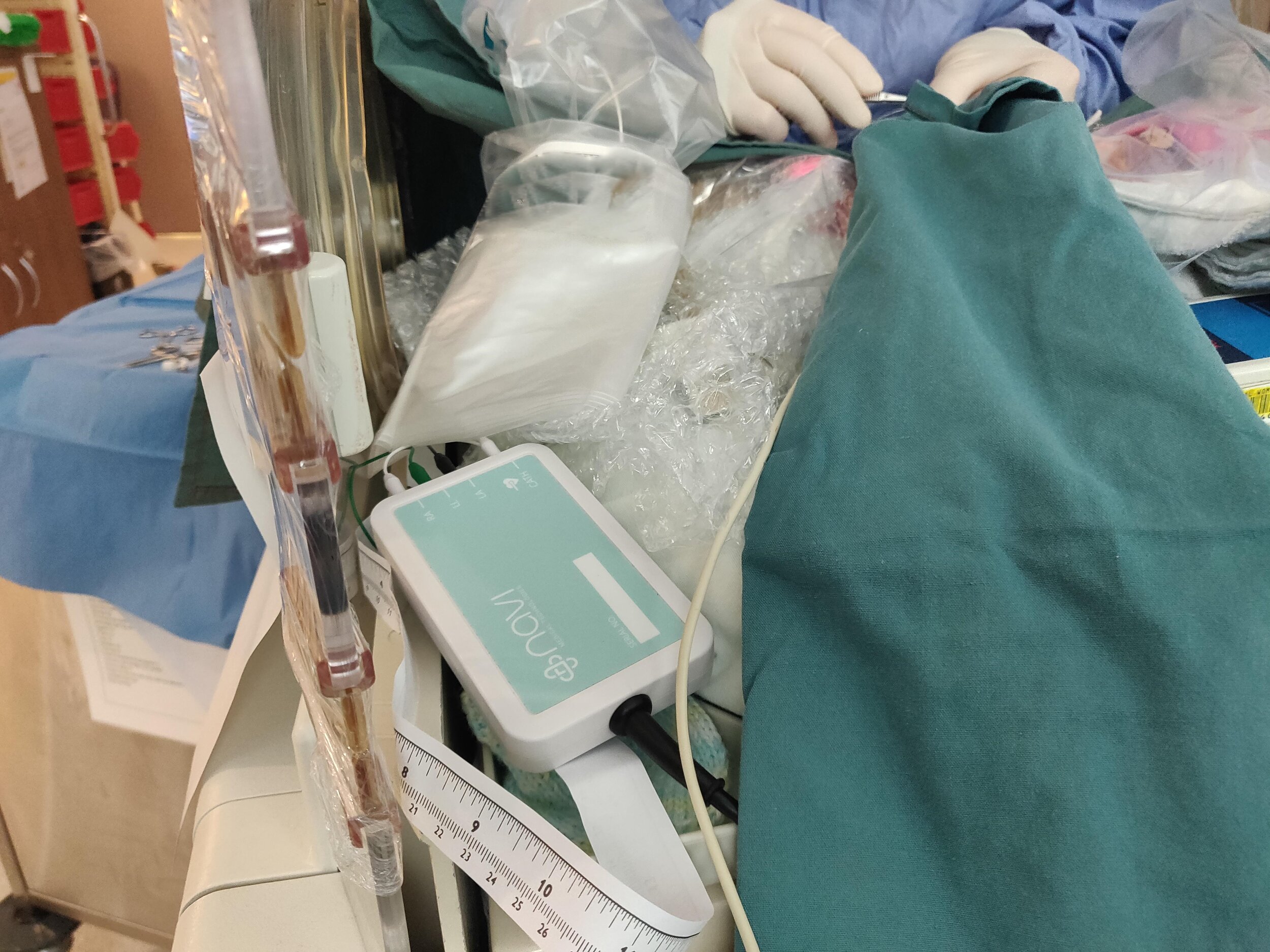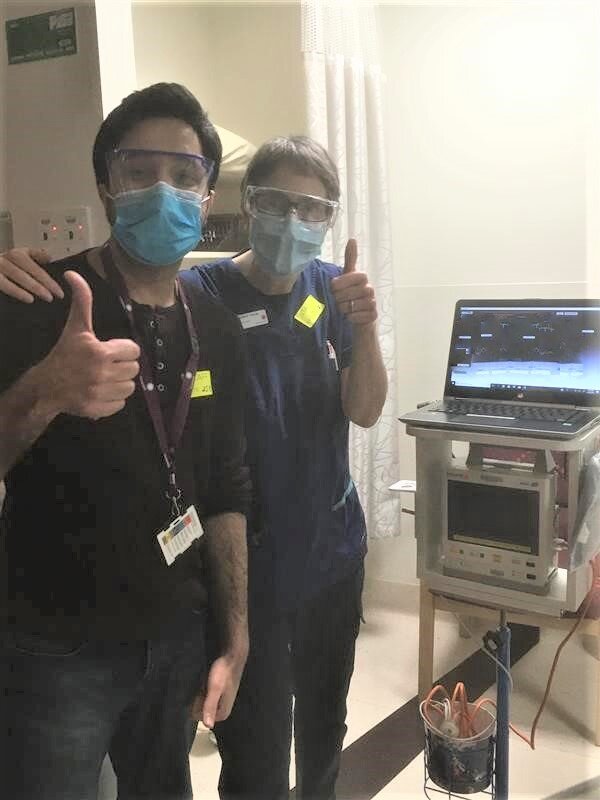From restrictions, to lockdowns, to the general fog of uncertainty, this past year has presented a number of challenges that required all businesses to embrace change.
Despite these pandemic challenges, the team at Navi made significant progress towards our vision of giving children brighter, healthier futures through medical innovations. Below are some of the 2021 highlights:
Expanded Our Clinical Activities
Lockdowns and restrictions brought on by the COVID-19 pandemic had a significant impact on clinical activities, with hospitals taking precautionary measures that included halting clinical research for a period of time.
Pictured: The Neonav® clinical prototype used during the Navi feasibility study and the Royal Women’s Hospital in Melbourne, Australia.
Pictured: Mubin Yousuf and A/Prof Christiane Theda at the Royal Women’s Hospital in Melbourne, Australia.
Despite this setback, our research team, headed by Navi Chief Medical Officer A/Prof Christiane Theda and CTO Mubin Yousuf, made some significant progress on our clinical research activities.
The Neonav® feasibility study, which involves the use of the Neonav® clinical prototype device to record real-world patient data, is in its final stages. To date, over 120 patients have been recruited across multiple studies that cover both Umbilical Venous Catheterisation (UVC) and Peripherally Inserted Central Catheter (PICC) procedures, with hundreds of data points being logged and incorporated into our proprietary location detection algorithm technology.
Local & Global Recognition
Navi’s work on the Neonav® Tip Location System had received attention both domestically and abroad this year, which included significant media exposure, as well as participation in a number of high profile events:
Parliamentary Recognition
A highlight was the Navi team receiving recognition from Federal Minister Karen Andrews, who made a notable mention of Navi as a leading example of next generation of innovative healthcare businesses as part of her address to parliament.
National News Coverage
The work Navi has been doing was also featured on Channel 7 News, where Navi CEO Alex Newton was interviewed as part of a prime time news segment that shared some patient stories and successes from our clinical research at The Royal Women's Hospital.
Additionally, the Herald Sun included a feature article that focused on the real-life impact the Neonav® has had during its clinical study at the Royal Women’s Hospital.
Presented At The Association For Vascular Accesses (AVA) In The USA
Across the pacific in the United States, Navi Chief Medical Officer A/Prof Christiane Theda and CEO Alex Newton presented (virtually) at this year’s Association For Vascular Access (AVA) conference.
AVA is a leading multidisciplinary community that seeks to advance research to bring about evidence-based innovations in vascular access. At the conference, both Alex and Christiane shared the results of the recent Neonav® clinical studies surrounding the Electrocardiogram (ECG) Waveforms Associated with Central Venous and Arterial Catheterisations in Neonates.
Participated on a global stage
Navi also participated in some of the worlds largest pitch competitions and accelerators in 2021:
Awarded finalists in the Extreme Tech Challenge (XTC), which is the worlds largest start up competition for purpose-driven companies.
Navi took part in the MedTech Innovators APAC Accelerator Program, which only accepted the top 20 medtech startups in the Asia/Pacific region to take part.
Both the XTC and the MedTech Innovator programs provided a global platform to introduce our technology to a broader audience, and receive valuable feedback and validation to help drive further progress.
Grants and funding
Navi was successful in a number of grants during 2021, with notable wins including the Victorian Government’s Victorian Technology Adoption & Innovation Program (TAIP) grant. This grant provided important financial support towards core product development activities, but also provided significant media exposure that launched Navi into the national spotlight.
Additionally, Navi was also awarded the Federal Government’s Entrepreneurs program – growth grant, which helped support key business development activities.
Navi also finished up the Accelerating Commercialisation Grant project, which was awarded by the Federal Government, and provided matched funding to support important product development and clinical milestones during the 2021 period.
Significant Product Development Milestones
This year brought further advancement in the Neonav® development, with significant progress made on both the Neonav® capital hardware, as well as the consumable componentry that form a core part of the Neonav’s ecosystem. Both aspects of product development have been progressed to advanced stages of the design process.
This video explains how the Neonav® ECG Tip Location System works, as well as its benefits compared to the current standard of care:.
Increased Accuracy
Preliminary testing of the Neonav® algorithm with real-world procedural data collected from our ongoing clinical studies achieved an accuracy of over 93% for catheter tip location detection for UVC procedures. This result is extremely encouraging, and is a strong indictor that greater accuracy is to be expected as more data is collected and the technology matures over the coming 12 months.
“[The Neonav®] achieved an accuracy of over 93% for catheter tip location detection for UVC procedures.”
Moved into our new home
This year also saw the Navi team move to our new home at Melbourne Connect, which is a purpose-built innovation precinct right in the heart of the city’s Biomedical precinct, and is a powerhouse innovation and collaboration in Melbourne.
We are grateful to be a part of such an amazing, inspiring community of emerging thinkers and leaders in Melbourne.
Growing the Navi family
The latest member of the Navi family was welcomed in October 2021, with the birth of Oliver “Ollie” Newton, Navi CEO Alex Newton’s second child.





